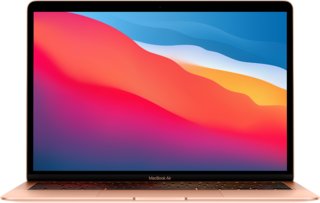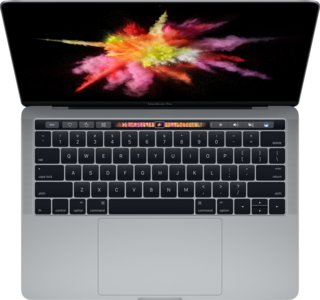Apple MacBook Air (2020) 13.3" Apple M1 vs Apple MacBook Pro (2017) 13" with Touch Bar and Touch ID / Intel Core i5 512GB
In the competitive landscape of streamlined design and high functionality, Apple's MacBook Air (2020) and MacBook Pro (2017) are two noteworthy options. Each is equipped with features that would impress any tech lover, presenting strong capabilities. But which one is truly superior? We're comparing these two powerful models to aid you in making a knowledgeable choice. From the innovative M1 chip in the MacBook Air to the convenient Touch Bar on the MacBook Pro, we'll thoroughly discuss all the unique aspects that differentiate them. So relax, get your favorite drink, and accompany us on this informative exploration!
System and application performance
Performance in popular 3D games
Viewing angle, color accuracy...
Ports, webcam and other interfaces
Potential battery life
Materials, durability and portability
Design Comparison
Size Comparison
When comparing the design of the Apple MacBook Air (2020) to the Apple MacBook Pro (2017), various factors affect user experience. Let's explore how these designs impact usability and aesthetics for users such as students and professionals:
Ergonomics and Portability:
- MacBook Air 2020: Weighing just 2.8 pounds, the MacBook Air is lighter than the MacBook Pro, enhancing portability for users on-the-go. Its fanless design not only reduces weight but also ensures a quiet and dust-free experience for prolonged usage.
- MacBook Pro 2017: Weighing in at 3 pounds, the MacBook Pro includes a touch bar feature that can enhance workflow efficiency for professionals needing rapid access to functions. Yet, this feature may not be essential for students or casual users focused mainly on portability.
Materials and Build Quality:
- Both laptops have the same dimensions in width, height, and thickness, highlighting Apple's commitment to sleek design aesthetics. The premium aluminum build of both models guarantees durability while retaining a polished appearance ideal for professional environments.
Unique Design Features:
MacBook Air 2020: The addition of a fingerprint scanner elevates security and convenience by allowing for swift logins while maintaining sleek aesthetics. Equipped with Dolby Atmos compatibility and three microphones, this model delivers exceptional audio performance ideal for video calls or enjoying multimedia content.
- MacBook Pro 2017: Although lacking a fingerprint scanner, the MacBook Pro compensates with an additional Thunderbolt port that can be valuable for users requiring multiple external connections simultaneously. Professionals may find this feature more beneficial compared to casual users.
Usability and Connectivity:
- The laptops feature backlit keyboards and Thunderbolt ports to accommodate different user preferences. The MacBook Air supports Wi-Fi 6 for faster wireless connectivity compared to the Wi-Fi 5 version in the MacBook Pro, enhancing performance for tasks with high data transfer needs.
Aesthetic Appeal:
- Both models feature a simple design that adds to their timeless charm, making them visually appealing no matter the trends or settings. Their sleek profile and clean lines are perfect for students who want stylish and functional devices or professionals looking for a sleek accessory in business environments.
In summary, both laptops feature premium design elements tailored to different user preferences. Choosing between them depends on individual priorities. Those valuing portability and enhanced security may prefer the MacBook Air. Conversely, professionals needing more connectivity options might opt for the MacBook Pro despite its slightly heavier design.
Screen Comparison
| Apple MacBook Air (2020) 13.3" Apple M1 | Apple MacBook Pro (2017) 13" with Touch Bar and Touch ID Intel Core i5 512GB | |
|---|---|---|
| Resolution | QHD | QHD |
| Screen Size | 13.3" | 13" |
Comparing the screens of the Apple MacBook Air (2020) and the Apple MacBook Pro (2017) involves considering key aspects that can influence user experience, especially for activities such as gaming or professional graphic design.
Screen Size:
Both laptops have a 13.3-inch screen, striking a balance between portability and usability. While a larger screen may enhance visuals for gaming or design tasks, it can compromise portability.
Resolution:
Both laptops have a resolution of 2560 x 1440 pixels, providing crisp and detailed images. This level of detail is particularly useful for tasks that demand clear visual precision, like graphic design work where each pixel is crucial.
Pixel Density:
Both laptops boast a pixel density of 227 pixels per inch (ppi), ensuring clear and sharp visuals. The increased pixel density enhances the viewing experience, making images and text appear sharper whether you're gaming or editing photos.
Display Technology:
Both laptops come with IPS (In-Plane Switching) LCD LED-backlit displays. IPS technology delivers superior color reproduction and wide viewing angles, ideal for tasks like graphic design that demand precise color accuracy. LED backlighting guarantees vivid and bright colors throughout the screen.
Brightness:
The MacBook Air (2020) offers a brightness of 400 nits, enabling it to display brighter visuals than the MacBook Pro (2017). Increased brightness is advantageous in well-lit settings or while working outside to mitigate glare issues.
Supported Displays:
The MacBook Air (2020) supports two external displays, which can enhance multitasking and provide extra screen space for managing multiple projects efficiently.
In gaming scenarios, the high resolution and pixel density of both laptops contribute to immersive gameplay experiences with detailed graphics. The IPS displays ensure accurate color representation essential for gaming environments where color precision impacts visual quality.
For professional graphic design tasks, the combination of high resolution, pixel density, IPS technology, and LED backlighting on both laptops ensures precise image rendering with accurate colors and sharp details. Designers can rely on these screens for accurate color matching and detailed editing work critical in graphic design workflows.
Hardware Comparison
| Apple MacBook Air (2020) 13.3" Apple M1 | Apple MacBook Pro (2017) 13" with Touch Bar and Touch ID Intel Core i5 512GB | |
|---|---|---|
| CPU | Apple M1 | Intel Core i5 |
| RAM | 8GB | 8GB |
| Storage Size | 512GB | 512GB |
Apple MacBook Air (2020) 13.3" with Apple M1 Chip, 8GB RAM, and 512GB SSD.
CPU: Apple M1The Apple M1 chip is a processor specifically designed by Apple, equipped with an 8-core CPU that includes both high-performance and efficiency cores.
- The M1 chip boasts impressive performance with its 5nm semiconductor size, offering power efficiency.
GPU: Integrated Graphics- The Apple M1 chip in the MacBook Air (2020) delivers integrated graphics that excel in everyday tasks and light gaming.
RAM: 8GB LPDDR4XThe MacBook Air features 8GB of fast RAM running at 4266 MHz for seamless multitasking and smooth application performance.
Storage: 512GB SSD- The MacBook Air comes with a 512GB SSD storage that is both spacious and fast, guaranteeing swift boot times, quick application launches, and sufficient file storage capacity.
Practical Performance Impact: The Apple M1 chip, along with integrated graphics, guarantees seamless performance for multimedia duties such as photo editing, video streaming, and casual gaming. The fast RAM speed boosts multitasking efficiency, enabling smooth transitions between applications without delays. The ample SSD storage capacity allows for fast data access, leading to improved system responsiveness.
Apple MacBook Pro (2017) 13" with Touch Bar and Touch ID, Intel Core i5 3.1GHz, 8GB, and 512GB.
CPU: Intel Core i5 3.1GHz- The MacBook Pro (2017) offers dependable performance for a range of computing tasks with its Intel Core i5 processor clocked at 3.1GHz.
GPU: Integrated Graphics- Like the MacBook Air (2020), the MacBook Pro also features integrated graphics that offer solid performance for everyday graphical tasks.
RAM: 8GB DDR3
- The MacBook Pro features 8GB DDR3 RAM which may offer slightly lower performance compared to the LPDDR4X RAM found in newer models like the MacBook Air (2020).
Storage: 512GB SSD
- With a similar storage capacity as the MacBook Air, the MacBook Pro's SSD provides fast read/write speeds for swift data access and system responsiveness.
Practical Performance Impact: The Intel Core i5 processor in the MacBook Pro performs well for everyday computing tasks. However, it may exhibit limitations with more resource-intensive applications compared to the Apple M1 chip.
- Despite having sufficient RAM and storage capacity, DDR3 RAM technology may not be as effective as LPDDR4X in maintaining peak performance while multitasking or running demanding software.
Conclusion
The Apple MacBook Air (2020) stands out with its advanced Apple M1 chip that delivers superior processing power, efficient multitasking capabilities, and excellent graphical performance ideal for modern multimedia tasks. Comparatively, the older Intel-based MacBook Pro (2017) offers reliable performance but might fall short in processing efficiency under heavier workloads. For users emphasizing speed and future-proofing their investment, the MacBook Air (2020) emerges as a compelling choice.
Battery Comparison
| Apple MacBook Air (2020) 13.3" Apple M1 | Apple MacBook Pro (2017) 13" with Touch Bar and Touch ID Intel Core i5 512GB | |
|---|---|---|
| Battery Life | 18 hours | 10 hours |
When comparing the battery performance of the Apple MacBook Air (2020) and the Apple MacBook Pro (2017), there are some notable differences to consider:
Apple MacBook Air (2020) 13.3" with Apple M1 Chip, 8GB RAM, and 512GB SSD:
- Battery Life: With an impressive battery life of up to 18 hours, the MacBook Air is perfect for users who need extended periods of productivity or entertainment without the hassle of frequent recharging.
- Sleep And Charge USB Ports: Enjoy the ease of charging your devices with sleep and charge USB ports, allowing you to power up your devices while your MacBook Air is in sleep mode, enhancing its battery functionality.
Apple MacBook Pro (2017) 13" with Touch Bar and Touch ID featuring Intel Core i5 3.1GHz, 8GB RAM, and a 512GB storage capacity:Battery Life: The MacBook Pro provides a battery life of up to 10 hours, suitable for daily use but less enduring than the MacBook Air.
If you need a laptop with extended battery life for work or leisure while traveling, the Apple MacBook Air (2020) offers an impressive 18 hours of usage. However, if features like Touch Bar and Touch ID are essential to you and you have more moderate usage requirements, the Apple MacBook Pro (2017) could be a suitable option despite its slightly shorter battery endurance.
Verdict
Why Apple MacBook Air (2020) 13.3" Apple M1?
- Superior processing power and efficiency with the Apple M1 chip.
- Longer battery life of up to 18 hours for extended productivity and entertainment.
- Lightweight design at 2.8 pounds for enhanced portability.
- Future-proof investment with advanced technology for modern tasks.
Why ?
- If you prioritize having a Touch Bar for enhanced workflow efficiency, the MacBook Pro (2017) is the better choice.
- Professionals needing multiple external connections simultaneously may find the additional Thunderbolt port on the MacBook Pro (2017) valuable.
- The MacBook Pro (2017) offers a sleek design with Touch ID, catering to users who value security and convenience.
- For users requiring features like Touch Bar and more connectivity options, the MacBook Pro (2017) presents a compelling option over the MacBook Air (2020).
Similar comparisons
- Apple MacBook Air (2017) 13.3" Intel Core i5 128GB vs Apple MacBook Air (2020) 13.3" Apple M1
- Apple MacBook (2016) vs Apple MacBook Air (2020) 13.3" Apple M1
- Apple MacBook Air (2018) 13.3" Intel Core i5 vs Apple MacBook Pro (2020) 13.3" Apple M1
- Apple MacBook Air (2017) 13.3" Intel Core i7 vs Apple MacBook Pro (2017) 13" with Touch Bar and Touch ID / Intel Core i5 256GB
- Apple MacBook Air (2017) 13.3" Intel Core i5 256GB vs HP Envy x360 13 (2020) AMD Ryzen 5 4500U

